Eco-Friendly Building Practices in the Middle East: A Guide to Sustainable Construction
Introduction to Eco-Friendly Building Practices
As the world embraces sustainability, the Middle East is making significant strides in adopting eco-friendly building practices. With climate change posing a major threat, the construction industry in this region is increasingly focusing on reducing its carbon footprint. By integrating sustainable methods, the Middle East is not only preserving its rich natural resources but also setting an example for other regions.

The Importance of Sustainable Construction
Sustainable construction involves using processes that are environmentally responsible and resource-efficient throughout a building's life cycle. This includes everything from design and construction to operation and maintenance. By prioritizing sustainable methods, the Middle East can ensure long-term ecological balance and reduce waste, ultimately fostering healthier communities.
Benefits of Eco-Friendly Building
There are numerous benefits to adopting eco-friendly building practices, such as:
- Reduced Environmental Impact: Sustainable construction minimizes resource depletion and reduces waste.
- Energy Efficiency: Green buildings often use less energy, lowering costs and reducing greenhouse gas emissions.
- Improved Indoor Air Quality: Eco-friendly materials can lead to healthier indoor environments.

Key Sustainable Building Practices
The implementation of sustainable building practices involves several key strategies that can be adapted to the unique climate and resources of the Middle East.
Use of Local and Recycled Materials
By sourcing materials locally and incorporating recycled content, builders can significantly reduce transportation emissions and support the local economy. This not only decreases the carbon footprint but also promotes sustainability in material usage.
Energy-Efficient Design
Designing buildings with energy efficiency in mind is crucial. This includes optimizing natural light, utilizing solar panels, and integrating advanced HVAC systems to reduce energy consumption.

Challenges and Opportunities
While there are challenges in implementing eco-friendly building practices, such as initial costs and regulatory hurdles, there are also tremendous opportunities. Governments in the Middle East are increasingly offering incentives for sustainable construction, which can offset initial investments and lead to long-term savings.
The region's unique climate presents both challenges and opportunities for innovation. For example, leveraging passive cooling techniques and water conservation methods can lead to breakthroughs in sustainable construction.
The Future of Sustainable Construction in the Middle East
The future of eco-friendly building practices in the Middle East is promising. With a growing commitment to sustainability, developers are poised to create environmentally responsible structures that meet the needs of future generations. By continuing to innovate and adapt, the Middle East can lead the way in global sustainable construction efforts.